
Temecula Valley Rose Society
Established 1991
Annual Birds in Rose Haven Garden
Index of Rosehaven Birds - 2021
Tap/Click the button to read our copyright policy... The Temecula Valley Rose Society (TVRS) respects the intellectual property of others and holds no claim to copyrights of Content that are owned by a third party or are in the public domain. All trademarks and registered trademarks, product names, logos, and brands used by the TVRS are the property of their respective owners. All company, product and service names used in this newsletter or website are for identification purposes only. Use of these names, logos, and brands does not imply endorsement.
January Birds in the Garden
by Linda Freeman, photos by Linda Freeman
Riverside County is home to approximately 465 bird species! We are fortunate that many of these birds reside in our area, Southwest Riverside County, and visit or reside in Rose Haven and our personal gardens.
With the renovation of our pond, many more birds may visit us this year, especially during Spring and Fall migrations as the sound of running water is very attractive to birds. Get your binoculars ready and visit Rose Haven. We will feature several resident and migrating birds each month in our Newsletter.
This month's birds are the Goldfinches, California Towhee and winter visitor, the White Crown Sparrow and the Black Phoebe. These birds are regularly seen at Rose Haven. A winter County visitor is the Cedar Waxwing.
The White Crown Sparrow

The White Crown Sparrow (note the white crown stripe and white stripe over the eyes; females have less prominent stripes) are the harbingers of winter in Southern California. They start arriving in late September to winter in our area and leave in late spring. They do not nest in our area. This bird is a ground feeder and is looking for seeds and nuts, and sometimes insects. If you have birdfeeders, they will frequently eat seed that has fallen from the feeder.
California Towhee
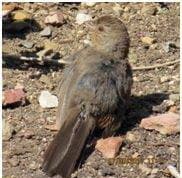
The California Towhee is a very inconspicuous year-round LBR – Little Brown Bird. It is also a ground feeder and loves to scratch in leaf litter to find insects. Leaving leaf litter and being a messy gardener helps these birds. You will more likely hear their rustling of leaf litter under shrubs than their call. The Towhee is not a strong flier and glides more than it flies. They like dense gardens for nesting and leaf litter.
Black Phoebe

The Black Phoebe is an insect eater, and they like to perch on fences or low branches and will inspect for insect activity and catch their prey, and often fly back to the same perch and repeat that activity many times which makes them fun to watch. They nest in our area and build nests under eaves. They are great friends of gardeners. These birds are sometimes called a Tuxedo bird as they have a white area under their breast that makes them look formally dressed! This bird is regularly seen at Rose Haven as we have a water feature.
Goldfinches
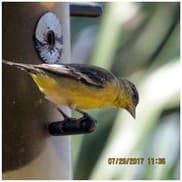

The Lesser Goldfinch (pictured) are small birds that love feeders in the winter months when seed is less available in the garden. They are seed eaters and year-round residents. They love thistle seed. They make sort of small "tee‑yee" call. They love shrubs and trees for nesting. The American Goldfinch male is frequently seen in winter with brilliant yellow head and body and a black cap, wings and tail. American Goldfinches always have white bars and a white rump and white undertail feathers. Planting Cleveland Sage in a corner of you garden will make Goldfinches happy in the Fall.
Cedar Waxwing

Photo © Evan Lipton | Macaulay Library Cornell Lab of Ornithology.
The Cedar Waxwing is a wonderful bird to spot during winter migration. They flock in treetops and love berries from Pyracantha, elderberry, cedar and privet. They are only here for a short time and are a treat to see.
Getting ready for the Great American Backyard bird count February 12‑15, 2021? Here is a link for information https://www.birdcount.org/.
The Cornell Lab of Ornithology is a great resource for bird information, pictures, and bird songs at https://www.allaboutbirds.org/news/.
Birding tips for the month: Invest in a good pair of binoculars which will last a lifetime. Audubon Society research finds most birders prefer 7‑ or 8‑power binoculars because they're bright and have a wide field of view, making it easier to find birds and to follow them in flight. Optics with objective lenses, the glass at the fat end of the tube, larger than 42mm are heavier, and those smaller than 30mm, while lightweight, aren't bright enough to show detail in poor light.
Also, do all tree trimming NOW. Birds start nesting January to August.
February Birds in the Garden
With our unseasonable January heat wave many Riverside County birds have started nesting early.
Phainapepla
The birds to keep a look out for are the Phainapepla, which nests in our area in the winter/spring timeframe, the and the Mourning Dove, a year‑round resident, and a look alike known as the Eurasian Collared Dove.
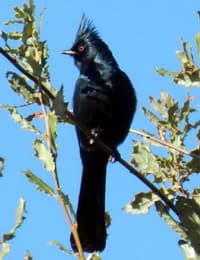
Male Phainapepla
Photo by Dan Wyncott

Female Phainapepla
Photo by Dan Wyncot
Member Dan Wyncott took these great pictures of a male and female Phainapepla at Rose Haven when pruning. Catching a picture of both the male and female was very lucky.
These birds love mistletoe berries and also catch flying insects for their diet. The crest is very distinctive of this species as is the glossy black of the male. They nest in the winter in our area in trees and shrubs, and this pair looks like they might be thinking of a nest at Rose Haven.
During the summer months they are more often seen in the Southern deserts. Note that the female is lighter colored gray.
Hooded Oriole
Hooded Oriole nesting can start in late February. They migrate from Northern Mexico and Central America along the Western U.S. with arrival times from late February to late March. They are the size of a robin. They are a skittish bird and nest almost exclusively in Palm Trees. They use palm leaf fibers to weave a hanging nest. If you have palm trees and citrus in your yard, Hooded Orioles may visit your garden from March to August.
Orioles are insect eaters and eat fruit, and they like nectar from Hummingbird feeders. Now is a good time to buy a dedicated Oriole feeder as their beaks are larger than Hummingbirds and they appreciate a separate feeder. They will need nectar and hydration after their long migration journey to our area. They will voraciously consume figs and other fruit in late July as they get ready for their return migration.

Photo by Linda Freeman

Photo by Linda Freeman

Photo by Linda Freeman
Mourning Dove

Photo by Linda Freeman

Photo by Linda Freeman
Mourning Doves are year‑round residents of our area and can raise several families during the year. Their soft "coo" call is very distinctive. Listen to the sound clip from All About Birds from the Cornell Lab of Ornithology.
The female is slightly smaller than the male. They feed almost exclusively on seeds, including weed seeds (be careful if you spray for weeds!). They are primarily are ground feeders but will also feed on seed platforms. They mate for life and prepare very flimsy nests in tree crotches from twigs, but you often find them making nests on patios and in hanging plant containers.
Eurasian Collard Dove

Photo by Linda Freeman
Eurasian Collared Doves (note the Collar on the neck) are an introduced species. They were introduced to the Bahamas in the 1970's and then rapidly advanced in to the United States. Their call is more impatient and less subdued than the soft "coo" of the Mourning Dove. They are also seed eaters.
Birding tips for the month: Purchase a dedicated Oriole Feeder (they have a bigger beak opening and are orange colored), visit the All About Birds site maintained by the Cornell Lab of Ornithology (https://www.allaboutbirds.org/guide/) for great pictures and migration routes, sounds and habits.
The Cornell site is a great place to get ready for the Great Backyard Bird Count in February. The 'Wild Birds Unlimited' retail store in Riverside has many species specific bird feeders.
Happy Bird watching, and please send me any pictures of birds you may see at Rose Haven to lee.linda@verizon.net for future Birds in the Garden articles!
March Birds in the Garden
Spring is sneaking up on us between our heat waves. The first wonderful song of spring is the House Finch. If you have a large grassy area, Robins may be visiting you and California Quail may start scurrying with their young. If you walk out at dusk you may hear Barn Owls as they scout the neighborhood for prey. A very dramatic visitor, the Black Headed Grosbeak, may be seen at your feeder as it migrates through our area
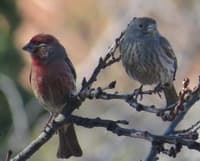
House Finch
Photo by Linda Freeman
The House Finch's song means spring is here! These sweet little singers flit about our yard and feeders. The male develops a rosey head and breast and the female is very plain. House Finches love to eat weed seeds and thistle seeds from a feeder. Sometimes they will eat opening buds and blooms and ripening berries. They will nest almost anywhere and they are gregarious in groups. They stay close to their nesting sites. It isn't spring until you hear the House Finch song.

American Robin
Photo by Linda Freeman
Robins love lawns and golf courses to find worms in the grass in the spring. They will feed on some berries and some seeds in the winter. The male has the prominent Red Breast. Robins like suburban shrubs and horizontal surfaces for nesting that are near lawns.

California Quail
Photo by Linda Freeman
Both female and male California Quail have the definitive comma shaped head knot but the male's knot is more prominent. The young scurry behind the adults as a covey and are very well camouflaged. They can be seen in parks that have Chaparral and oak woodlands. They are ground feeders and are seen below shrubs.

Barn Owl
Photo by Darren Clark
Macaulay Library-Cornell
Barn Owls have a high-pitched call, not like the typical "hoot" of other owls. They are strictly nocturnal and they love to nest in dense trees and palm tree beards where the thatch covers them during the day as they roost. They can often be seen perching out on a palm frond at dusk to get ready for their evening rodent patrol. Farmers love these owls for rodent control and owl boxes are frequently built to house pairs. Barn Owls eat their prey whole and then cough up pellets which are a great delight to classroom children that love to dissect the pellets, and to hikers.

Black-Headed Grosbeak
Photo by Linda Freeman
This spring-time visitor will nest in our area and then migrate to Mexico for the winter. They build twiggy nests and enjoy tree seeds and some fruits and berries and insects. They are often seen at feeders as they arrive from their long migration. The male has the very bright cinnamon coloring and the female is less vibrant in color but both have wing linings that are seen in flight.
Birding tips for the Month
FEEDER CLEANING throughly with bleach is essential. California Fish and Wildlife has requested that we all stop feeding wild birds (including but not limited to) finches and siskins, as well as hummingbirds due to a recent Salmonella and Bacteria outbreak. Member Dan Wyncott brought this to my attention and now more information is available about this regional outbreak. All feeders should be taken down and emptied and cleaned with bleach and water and air dried. Information about this is conflicting, but many say a two-week break and then putting clean feeders back up with fresh seed may be enough. Migrating birds can spread this if your feeders harbor the Salmonella or Bacteria.
These upcoming months are very important in the bird migration timeline! Thorough cleaning of feeders regularly is good practice. Using white vinegar as a rinse each time your replenish your hummingbird's feeders is also a good idea.
For excellent information about local birds the book Backyard Birds of the Inland Empire by Sheila N. Kee is a great home reference guide and "All About Birds-Cornell Lab" website has wonderful pictures, migration and distribution maps and recorded bird songs.
April Birds in the Garden
by Linda Freeman
All photos by Lindra Freeman except the House Wren
The House Finches are now singing and many have nested and are starting to feed their young but we now have a new voice in the garden - the Northern Mockingbird. Also, the Bewicks Wren is nesting and this tiny bird will hop around near your feet and scold you if you get near its nest and the House Wren and the House Sparrow are happily eating at feeders and everywhere in the garden - the are very resourceful finding food . A very dramatic colored visitor, the Western Tanager, is possible this month.

The night voice you may now be hearing is the Northern Mockingbird. Mockingbirds are known to sing on moonlit nights. Females and males look alike. Mockingbirds are great mimics - if you are in your garden and you think you hear a Crow but you do not see one, look for a Mockingbird which is distinguished by a white wing patch and it might be mimicking a Crow! They eat according to seasons - insects in the spring and summer and berries (Pyracantha berries are favorite) in the fall and winter. They are very protective of their nests and will dive-bomb cats and dogs and can inflict wounds that might need veterinarian attention - it is wise to keep your small pets away from Mockingbirds during nesting season! My cat was dive-bombed and I can report that the 10 day antibiotic shots now available are very effective.

Bewicks Wrens are year-round residents. The male and female look the same. Note the long white eye stripe as an identification marking. They have a very distinctive scolding voice if you are near their nests and they will hop around in front of you scolding. They are cavity nesters and can have several broods a year. Their main diet consists of insects. Notice the posture of this bird - its tail is upright and it will flick it sideways. This tail posture is very indicative of most Wren species. Many Wren species will use nest boxes that are specific to Wrens. The shape of the box and size of entry hole have to be specific to the Wren.

The House Wren is a plain wren but it has the distinctive Wren posture with the upright tail. Males and females look alike. Any crack or crevice can become a House Wren nest. House Wrens are insect eaters. Their song is a warble and can be heard at the Cornell library site https://www.allaboutbirds.org/guide/House_Wren/media-browser-overview/59860711
photo by Andy Witchger, MacCauley Library, Cornell.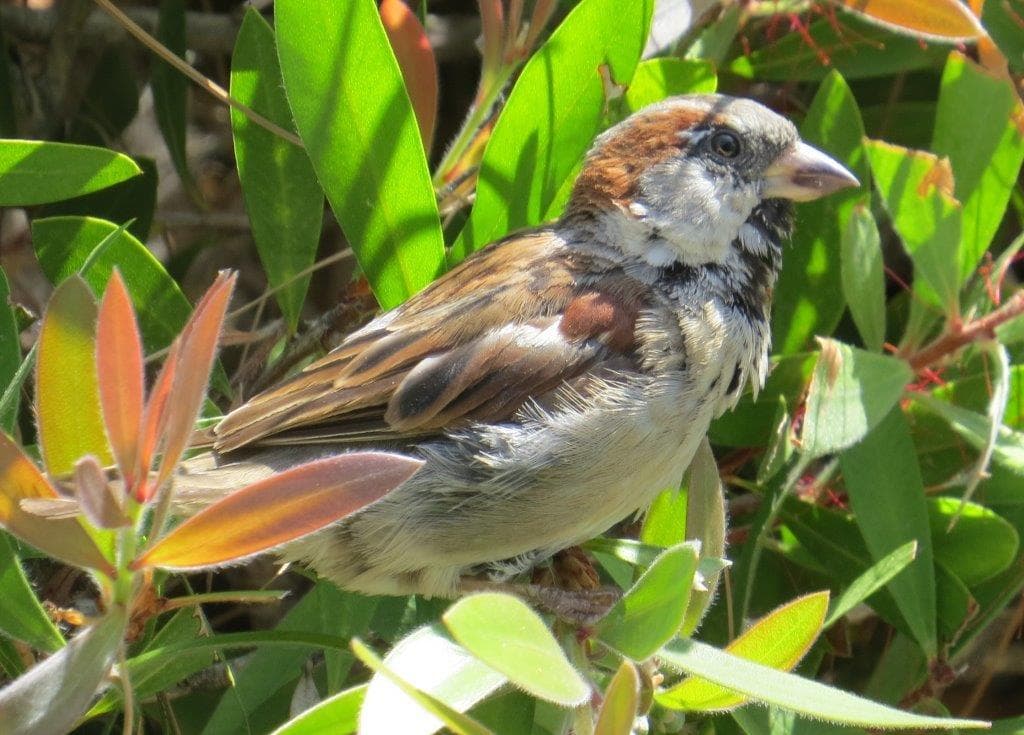
House Sparrows are not a native bird - they were introduced and sometimes are referred to as an English Sparrow. This photo is of male House Sparrow in breeding plumage with a more brown neck nape . The female is more plain brown. The House Sparrows utter a "cheeping" sounding song. They are not picky selecting nesting spaces. They will eat insects, weeds and fruit and whatever is available.

The Western Tanager is a very colorful bird that migrates through our area in spring and fall. The male will lose its red coloring on its head when not in breeding plumage and will look more like the female with a yellow-olive coloring. The wings have distinctive bars. They are insect eaters. This picture reflects a male in a Weeping Bottlebrush tree which yields lots of insects in the spring for birds to eat. Have your camera ready to try catching a picture of this vibrant visitor.
Birding tips of the month - Now is the time to try to learn your garden's specific bird songs. The Cornell All About Birds has over 600 birds species recordings - https://www.allaboutbirds.org/guide/search.The birds are all singing and you can start to identify the bird by its song before you even see it. Also, Bewicks Wrens are happy to nest in a bird house. You can Google "Wren House" to make sure you get the proper shape and correct entry hole size for your Wren house. They will not nest in the boxy type of houses frequently sold at craft shows. All Bird house entries should be placed away from the prevailing wind direction in your garden. Happy Spring birdwatching !
May Birds in the Garden
by Linda Freeman
During the month of May, many gardeners observe fewer birds coming to feeders. Since April and May are peak bloom times, many birds are finding their food in our gardens.
Hummingbirds will be very happy to sip nectar from ypur blooms, and there will be plenty of insects for their diet, too. This month we will cover some of our wonderful hummingbirds. In our climate zone they usually overwinter, but we do have the Rufous hummingbird visitor that can come to our feeders.
Hummingbirds are a New World bird and do not live anywhere else except North and South America. Hummingbirds can be a challenge to identify because their feathers are not pigmented, and their colors vary based on how the light hits their feathers and the process of refraction defects the colors.
Hummingbirds weigh about as much as a nickel coin. There are approximately 320 hummingbird species, and the U.S. has about 16 that are either year round or those that are seasonal visitors. The East Coast of the United Sates only gets to see the Ruby-throated and possibly the Rufous Hummingbird.
Anna's Hummingbird
Anna's Hummingbirds are our beloved year-round residents. They can start nesting as early as January before the migratory hummingbirds arrive, and can have two broods a year. The males are very protective of their territory and love to perch near a feeder to protect it. If you see two or more hummingbirds at a feeder it is probably a young family that is learning their territory.
They are only 4 inches in length. Note that the female has less refractive color. They will be very happy in your yard if you have tubular nectar plants.

Anna's babies outgrowing nest
Photo by Doug Freeman

Anna's female on nest
Photo by Doug Freeman

Anna's male
Photo by Linda Freeman
Costa's Hummingbird

Costa's male
Photo by Linda Freeman
Male Costa's Hummingbird: Costa's are becoming year-round residents in our area. The Costa's is slightly smaller than the Anna's at 3.25 inches, and a good way to tell the difference in low light situations is to look for the white eyebrow on the Costa's. Also, the purple crown and purple feathers in good lighting can also identify a Costa's. They appreciate the same habitat as the Anna's. Currently it is thought they only have one brood a year.
Black-chinned Hummingbird

Black-chinned male
Photo by Mike Stewart, Macaulay Library, Cornell.
Male Black-chinned Hummingbird male: Black-chinned Hummingbirds nest in our area from April to September and then migrate back to Mexico and Central America. They love nectar plants and eat insects. A good way to determine which hummingbird you are seeing in low light is to see how far the color on their throats extends down the front of their bodies. The Black-chinned does not have a long extension of color.
Allen's Hummingbirds

Allen's juvenile
Photo by Doug Freeman
Male Allen's Juvenile Hummingbird: Allen's Hummingbirds prefer Coastal California but can pop up in our area - the picture shown was taken at Sherman Gardens, Corona Del Mar. Note the darker wing color. They will winter in Mexico and can be seen in the foothills of Southern California.
Rufous Hummingbird - the Visitor

Rufous male
Photo by Doug Freeman
Male Rufous Hummingbird: The Rufous Hummingbird traverses our area as it migrates north from Mexico each spring. The Rufous glows orange in good light. It is a fierce protector of feeders while it takes a rest stop in our gardens and will drive away your local hummingbirds temporarily. They can migrate through mountain meadows at 12,000 foot elevations on their spring routes to Southern Alaska and the Northwest. The Rufous is known to flare its tail when it is in defensive mode.
Birding tips For The month
Hummingbirds are very territorial. You can attract more and keep the peace by adding a second or third feeder. Hummingbirds like to fly through sprinklers and also through waterfall-style fountains. Hummingbirds use spider webbing for their nests. Keep your garden spiders happy so the hummingbirds can use the webbing to add elasticity to their tiny nests! As temperatures rise, it is important to keep feeders clean and changed frequently. White vinegar and water is a good rinse for feeders.
Hummingbird calls are very "buzzy". To hear recorded hummingbird sounds you can go to here and type in 'hummingbirds' and listen to the various sounds that hummingbirds make. As you get more familiar with the birds in your gardens, it is a good idea to remember the Four Tips for bird identification: Study the size and shape of the bird, study the color pattern, study the behavior and how certain birds act in your garden and know the habitat the bird prefers. Happy Spring birding!
June Birds in the Garden
by Linda Freeman
As we transition to official summer on June 21, more and more birds will be seen training their young to feed and find local resources, like water. There will still be plenty of insects available, but water may be scarce, so keeping water sources clean will be a priority. The Western Bluebird was seen at Rose Haven on May 12, 2021 perching and observing insects from the education pavilion. The Great Egret and Great Blue Heron will be seen near Rose Haven's pond and Swallows will swoop along the pond (or backyard pools) for insects, and little groups of Bushtits will be gleaning insects also. That's why we love our birds - many are specialized insect eaters and help us with our gardens.
Western Bluebird
photo by Brooke Miller, Macauley Library
The male is very blue with a rusty vest. The female is a very dull tan color with a tiny bit of rust color on the breast. They devour insects and love mealworms. They are known as cavity nesters and look for trees first ,but they will use nest boxes placed high in trees and love nests that are placed in parks and golf courses. The nest box entrance hole should be no bigger than 1.5 inches to avoid other birds taking over the nest box.
Great Egret
photo by Nancy Kaplan-Fitness
Great Egrets are considered wading birds that reside in both freshwater and saltwater habitats. They nest in high trees to be safe from predators. In the spring they can often be seen hunting in fields that have residual rain water or on neighborhood lawns. They hunt very slowly for fish, frogs and lizards and when they take flight, they will tuck in their long neck.
Great Blue Heron
photo by Kathy Trudeau
Look for Great Blue Herons in saltwater and freshwater habitats and lakes and backyard goldfish ponds. They also forage in grasslands and agricultural fields. They build stick nests high off the ground in groups. The Great Blue is often called a crane but it is the largest of the North American Herons. They wade slowly or stand statue-like, stalking fish and other prey in shallow water or open fields. They stab their prey with their strong bills. They fly very slowly in the air. They eat mostly fish, but also frogs, salamanders, turtles, snakes, insects, rodents, birds and have been known to take gophers.
Cliff Swallows
photo by George Pagos, Macauley Library
There are several species of Swallows that can be swooping along Inland ponds or pools but the Cliff Swallow nests in the Inland Empire. These compact birds have rounded, broad-based wings, a small head, and a medium-length, squared tail. Without sun they look brown and dull but with sun refraction you will see you'll see their metallic, dark-blue backs and pale, pumpkin-colored rumps. They have rich, brick-red faces and a bright buff-white forehead patch. They zoom around in intricate aerial patterns to catch insects on the wing. When feeding in flocks with other species of swallows, they often stay higher in the air. They build mud nests in colonies on cliff ledges or under bridges, eaves, and culverts, bridges and overpasses. They feed in areas near and over water, frequently mixing with other species of swallows. The Cliff Swallow is the one that is known to return to Mission San Juan Capistrano annually from long migrations. Other Swallows that can be seen in our area are Barn Swallows, Violet-Green Swallows and Tree Swallows.
Bushtits
photo by Linda Freeman
Bushtits are tiny, about 4.5 inch sized birds. They are plump and large-headed, with long tails and short, stubby bills. Bushtits are fairly plain brown-and-gray birds. Bushtits move quickly through vegetation, almost always in flocks, and continuously make soft chips and twitters. They forage frequently hanging upside down to grab small insects and spiders from leaves. Bushtits build a hanging nest out of soft materials such as grasses and spider webs. They love shrubs for nesting. They make hanging gourd shaped nests. During winter they appreciate suet feeding. Bushtits frequently tap at residential windows during breeding season when they see their reflection in the glass.
Birding Tips for the month: Sadly, this time of year baby birds fall out of nests and for the best advice on how to deal with this, check out this great page from Wild Birds Unlimited in Riverside for a list of wildlife rehabbers Click/Tap here. Also, there is great article about assessing the situation to get the proper care for the bird. Also, when birds fly in to windows and are stunned, you can help them out by placing them in a low sided box in the shade on top of table away from predators and often they will get their bearings and fly off on their own; they just need some time. During our hot months keep your feeders and water sources clean.
August Birds in the Garden
by Linda Freeman, all photos by Linda Freeman unless otherwise labeled
August can be a challenging time in gardens for birds. Birds, like all living creatures, need water. Frequently seen cooling off in garden fountains are Coopers Hawks.
Roadrunners know irrigation system timing and can be seen drinking from basins around citrus and other plants. Fresh water is a great addition to the garden for birds.
Many adults are still training their young, and Nuttall's Woodpeckers can frequently be seen attached vertically to tree trunks searching for insects with their young are nearby watching and learning "Woodpecker 101".
Coopers Hawk
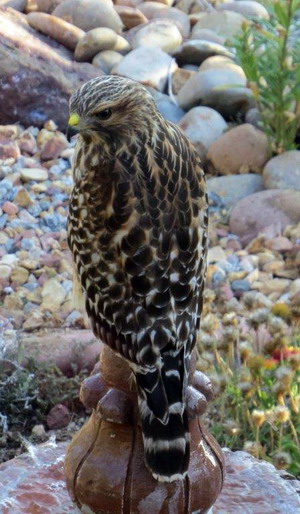
Coopers Hawks are frequent visitors to backyard gardens. The white stripes on their tail distinguish them from other hawks. They have a shorter wingspan and are able to fly more easily in more narrow garden spaces.
If you have an active bird feeder in your garden and you suddenly hear the bird chorus go silent there probably is a Coopers Hawk nearby, as they like to prey on smaller birds, are the size of a crow and perch stealthy on tree branches hoping not to be seen.
They nest in high trees. They will also prey on small mammals but small birds are their preferred prey.
Western Scrub Jay
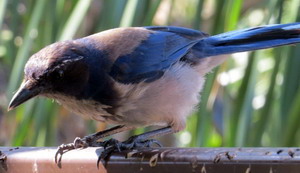
Scrub Jays live in our area year-round and are about the size of a Robin. Many homeowners feed the Scrub Jays peanuts and the birds are vary smart and will continue to come back on a regular schedule for more peanuts. They are a bluish- gray and they have a white-grey throat.They have a raucous call (especially when expecting peanuts). They do not sing.
They are primarily insect eaters but have been known to eat smaller birds and plants that have seeds or berries. They are adept at hiding food and it would not be unusual to find some peanuts stashed around your garden.
They are a member of the Corvid family of birds which include Crows, and have a great memory and are very intelligent. I attempted to grow an Almond tree for many years and a Scrub Jay would come and harvest the almonds and put the almond between its legs and peck open the almond to get the nut.
Nuttall's Woodpecker

Many of you have heard a Nuttall's and not realized it, as it is a fairly regular suburban garden Woodpecker where there are mature trees. You can hear their call here and might recognize it. You can usually hear them before you see them. During the summer you can often see two flying about together as one is a juvenile and is learning from the adult.
They are black and white, and the male has a black crown with red coloring along the nape. They are about 7 inches in size. They have very stiff tails which help them balance vertically and they have four toes: two face forward and two backwards to help balance. This is very common for woodpeckers.
They nest in cavities of dead trees or dead tree limbs and they glean insects from tree trunks and branches and hop around the tree trunk listening and probing for the insects. They would be happy with suet in the Fall and Winter months. They will drill into trees with heavy sap.
Greater Roadrunner

Roadrunners are year-round residents in our area. They are a large bird. They are brown with streaks. Note the blue and red patch behind the eye. Roadrunners are not good flyers and will glide or run. They love sunbathing and dust baths. Their song is a descending "0-0-0". Listen here. They build stick nests higher up in shrubs.
Roadrunners are meat eaters and love lizards and snakes and small birds and large insects. I have seen videos of them snatching Hummingbirds from feeders. Member Dan Wyncott caught this great shot of a Roadrunner with a lizard. Their young leave the nest after 3 weeks.
I had a citrus orchard and a Roadrunner visited like clockwork on the afternoons when the irrigation system was timed to flood the basins.
Greater Roadrunner, Photo by Dan Wyncott.
Bird tips of the month: Think about the birds you have seen in your garden so far this year and see if you could add some native plants in corners of you garden that would feed the birds so they are less reliant on feeders during the summer months.
Native foods will help the birds. Provide water for birds in the form of fountains or bird baths, keeping in mind they need to be refilled often and kept impeccably clean.
September Birds in the Garden
by Linda Freeman, UCC Master Gardener
Most photos by Linda Freeman.
September is another tough month in the garden for our birds. It can be hot, and food sources may have withered away. We still need to keep water sources clean and provide some food as migrating birds will now be heading south. Wildfires may disrupt migration and usual food sources, and water sources may not be available, and we might see some more rare migrants this year. Turkey Vultures are returning, and Red Tail Hawks and Red Shouldered Hawks are training their young to hunt. California Thrashers are being seen in gardens and our resident Crows are being their curious selves.

The Turkey Vultures are back! Turkey Vultures are considered partial migrants. They reside in our area year-round but many will migrate during the summer and then return for the winter. Turkey Vultures are carnivores and eat carrion. You will not see them at your feeder but they might visit a water feature and can be seen congregating in the morning on utility poles before they start their daily flights. They congregate in roost trees for evening sleeping. If you have a lake near you you might have a roost tree. Turkey vultures on the West Coast can migrate to Central America for the winter.

Red-Tailed Hawks (note red on tail in photo) are year-round residents and are large hawks, larger than the Coopers Hawks that visit our suburban gardens and the Red Shouldered Hawks that hide in our gardens. Females are slightly larger than the male. They prefer tall trees for nesting and for observing and will reuse the same nest each year. Their diet consists of small rodents, snakes, rabbits and larger insects. They have binocular vision which is essential for catching rodents. They soar slowly overhead looking for prey. They are more likely to be seen hunting in fields rather than suburban gardens but will perch in trees and on utility lines.

Photo by Eric Keith, Macauley Library. Red-shouldered hawks are fairly common year round residents in our gardens. They are slightly smaller than a Red Tail Hawk and are more slender with longer tails. It is good to learn their call as you are more likely to hear them before you see them. They return to their nesting territory each year. The eat mostly small rodents. They like a habitat with lots of trees and some natural water. A creek nearby is preferred by this hawk.

Crows are year-round residents in our area and can frequently be seen in flocks in the Fall and Winter. They can be seen flying as groups at dusk to their roost trees. They mate for life and build nests in large trees twenty to sixty feet above the ground. I have seen them build nests on office building window ledges in Temecula and Hemet. I have also heard them breaking off twigs and dry branches in the garden to carry to their nests. Crows eat almost everything. They also eat the young of other birds. Crows are very curious and love to people watch. Crows are sometimes confused with Ravens. A good way to remember the difference is the rhyme "Square Crow — Round Raven". The Crow has a more squarish wedge tail and the Raven tail is more round. Also, Ravens prefer more open spaces, not our suburban gardens.

PHOTO BY Luke Seitz, Macaulay Library. California Thrashers are Chaparral songbirds and love to work through leaf litter to find insects. They are related to Mockingbirds and also do some imitation songs. They can be mistaken for a Mockingbird but their bill defines them as a Thrasher. They can often be seen collecting dried twigs for nests which they like to build about 5 feet above the ground. We had good luck with putting small square wood pieces in to the crotch of our Citrus tree branches and leaving twig piles in the garden. Being a "messy gardener" brings bird rewards. Often you can hear the Thrasher but not see it. You can hear their song here.
October Birds in the Garden
by Linda Freeman
Finally, we have passed the Autumn Equinox and cooler weather should carry us in to winter. During these cooler fall evenings the Great Horned Owl can be heard calling. The Yellow Rump Warbler is a winter visitor to our area and will leave in May, and can be seen near water features this time of year. The Brewers Blackbirds are year-round residents in our area but will be seen more in flocks during winter.

Photo by Linda Freeman. The Yellow-Rumped Warblers are smaller birds that visit us more in the winter. They have yellow rumps and yellow crowns, yellow sides and throat patches. The female is a much lighter color. The picture shows the male in breeding plumage.
They can sometimes be seen in small flocks and they move very quickly, fly catching insects. In the winter they will eat some berries. They are attracted to gardens with a water source and plenty of insects to eat. They do not nest in our area, preferring mountain forests for nesting. They are sometimes affectionately referred to as "butter butts".

Photo by Mary Rumple, Macaulay Library. The Great Horned Owl is a sedentary and a permanent resident in our area. Their ear tufts are distinctive. They are more often heard than seen as they are nocturnal. Their shorter wings allow them to maneuver through forest and suburban gardens with many trees. If you are hearing more hooting than usual, there may be courtship in the air. The male vocalizes more loudly.
The owls are 18 to 25 inches in length, and the female is larger than the male. They can take large birds like hawks down to mice as their prey. The owl's fluffy feathers make them soundless when flying. Owls have immobile eyes requiring them to turn their heads to look. They can not turn their heads 360 degrees! These owls start nesting as early as January so it important that tree trimming be done before nesting season starts.

Photo by Jonathan Eckerson, Macaulay Library. Brewers Blackbirds are year-round residents. They tend to flock more in the winter. The males have distinctive glossy black necks and heads and yellow eyes. The females are a dull color with brown eyes.
They nest on the ground where they have cover from thick weeds or shrubs. They eat crickets, grasshoppers and caterpillars, as well as seeds and fruit. They are often seen walking in parking lots taking short stops and starts looking for food.
Birding tip of the month: Many birds we reviewed earlier in the year are now migrating south through our gardens again. The Cedar Waxwing and White Crown Sparrows and more Turkey Vultures are being seen in the Inland Empire. It is a good time to make sure all feeders are clean.
It is also a good time to find a corner of your garden for native plants to sustain birds. Fall is the best time to plant natives and take advantage of plants sales as plants will get established before next summer's heat. See upcoming events for California Native Plant sale dates.
Plants for seed and nut eating birds are Coreopsis, Mexican Sunflower, Coneflower, California sycamore. Fruit eating birds like Elderberry, Toyon, Crape Myrtle, Sugarbush, Roses. Nectar feeders like Bottlebrush, Sages, Bee Balm, Monkey Flower, Lemonade Berry. Insect eaters are attracted to Oak, Bottlebrush and Butterfly Bush. There are many more plants that attract wildlife and plant sales identify what wildlife is attracted to the plants that are for sale.
Birding tips of the month: Keep water features clean and fill feeders and leave leaf litter piles to help migrating birds find insects. Fall is the best time of the year to plant California native plants. September is a good time to plan a corner in your garden for native plants.
The California Native Plant Society will have plant sales in October where you can buy your preferred plants. Also, CNPS is having their first California Native Plant Festival, Saturday, October 9, 2021, 9:00 AM to 3:00 PM in Balboa Park, 1600 Village Place, San Diego. You can learn about the significance of California native plants for creating habitat and biodiversity. California native plants are optimal for saving water; attracting native birds, bees and butterflies; and preserving our natural heritage.
Also, CNPS is partnering with local nurseries to offer more native plants. Coming October 1st to a garden store near you! They have partnered with 115 nurseries around the state to 'Bloom! California,' a collaboration to increase native plants in California's built-up landscape, backyards, and beyond. Go To Bloom California.
November Birds in the Garden
by Linda Freeman
Fall is a transitional month for seeing birds. Our summer friends have left the area and migrated to their wintering grounds and other birds are migrating south in to our area for winter. Starlings are congregating on utility lines and Kestrels are perching and surveying for prey.


Photo by Matt Davis, Macauley Library. Photo Starlings congregating by Linda Freeman.
European Starlings are year-round residents in our area but seem to flock and group together more in the winter. Sometimes they are referred to as "Coffee Klatch" birds when you see them congregating on utility lines. In winter sunlight, the white speckles on their wings look like "stars". Starlings are an introduced species by a Shakespeare fan living in New York one hundred years ago who wanted one of each bird in the Shakespeare plays. Within sixty years, Starlings were in all of the US Continental states!
In the Spring, their dark bills turn yellow. Starlings will aggressively stride across lawns looking for insects. They are omnivores and will also eat fruit, weed seeds, garbage and snails. They try to nest in tree cavities or take over nests of other birds. Because they are aggressive, birdhouses that you have in your garden should have entrance holes smaller than 1-1/2 inches in diameter so Starlings can not enter.
Starlings are known to gather in flocks of thousands and when they all take to the sky, their seemingly coordinated swirling cloud in the sky is called a murmuration.
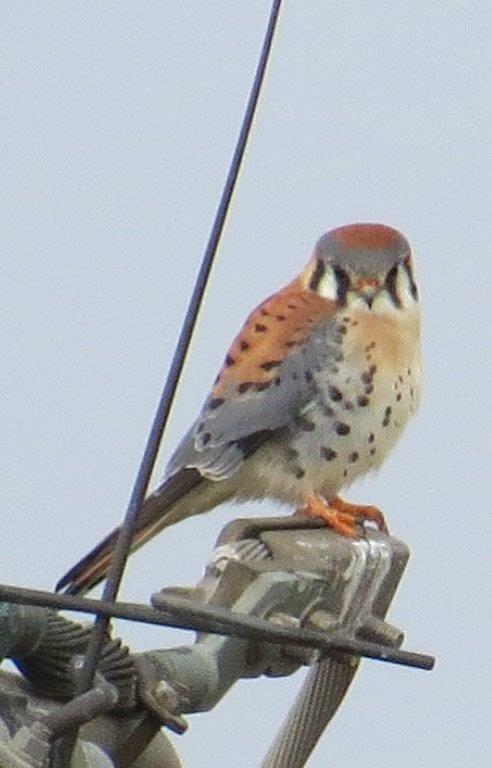
Photo by Linda Freeman.
American Kestrels are year-round residents in our area. They are often called Sparrow Hawks and are considered falcons. They are the size of a Robin. They hover-hunt, meaning they will hover over their prey when they spot it on the ground. They eat rodents, lizards and small birds. Kestrels love to perch on wood posts. They nest in tree cavities and usually have only one brood a year. They like suburban gardens that have adjacent open lands and accessible perches for hunting.
Birding Tips for November: Food resources for winter birds are shifting this time of year. They will appreciate clean feeders with appropriate seeds, nuts and fruits and maybe some bark butters for really cold weather. If little rain is predicted, clean water is appreciated by birds for drinking and bathing. Mealworms are a great food for the birds that are not seed eaters. The Goldfinches will be back and they love thistle seed.
Start your holiday gifting early and try to purchase the excellent book Backyard Birds of the Inland Empire by Sheila N. Kee. This book is out of print but can often be found on used book sites. The Riverside-Corona Resource Conservation District sometimes has limited quantities for sale for under $20.00. Contact them Mon-Fri, 8 a.m. - 3:30 p.m. at 951-683-7691, ext 201. If you are lucky enough to secure the book, a visit to their office in Riverside is very informative as they have a nature preserve and also another area as a Land Use learning center. Their website is here.
December Birds in the Garden
by Linda Freeman
As winter approaches we have some visitors that will stay with us until Spring. The Northern Flicker will be more visible in our gardens, the Dark Eyed Junco will be visiting, as well as the Ruby Crowned Kinglet. Winter is a good time to reflect on the birds that have visited your garden during the year and plan for habitat additions or changes to help birds with a supportive habitat in 2022.
Also, it is a good time to review what birds visited your garden and get ready to participate in the Great Backyard Bird Count to help monitor bird populations as Citizen Scientists. The 25th annual GBBC will be held Friday, February 18, through Monday, February 21, 2022. Please visit the official website at birdcount.org for more information, and be sure to check out the latest educational and promotional resources.

Photo by David Solas. Ruby-Crowned Kinglet. Ruby Crowned Kinglets do not nest in our area. It is very hard to see the Ruby crown on this bird as you need to be looking down at the crown to see it. Males and females look the same but males have the tiny ruby crown. They are the size of Hummingbirds. They nervously flit through gardens and glean insects. I have often seen them on Crape Myrtles in the winter and foraging in leaf litter. They are also attracted to suet and peanuts and other nuts.

Photo by Linda Freeman. Northern Flicker (Red Shafted). Northern Flickers are larger than Robins. Even though Flickers are Woodpeckers and have the toes that point forward and backwards for clinging to tree trunks, they like to forage more on the ground for ants. They also forage for other insects and they like berries. The Flicker of the West is the red-shafted and the red is seen on their wings and tail. They appreciate suet.

Photo by Sam Hough. Dark-eyed Junco. Juncos are the size of a sparrow and will move in flocks. Their black head extends to the top of their chest area and they have a whiteish belly. The are winter visitors to our area. They move to evergreen forests in the San Bernardino and San Jacinto mountains to nest. They are seed eaters and feed close to the ground and appreciate platform feeders close to the ground but not near any potential predators! They like evergreen trees as perches and love seeds from leftover annuals and perennials in your garden.
Bird tips of the month:Clean water is still essential for birds during the winter - especially during a drought period. Also, consider leaving leaf litter in your garden and take the "messy garden pledge" to help birds that need insects int heir diet.
Many of our winter birds appreciate feeders with nuts or suet. Holiday sales are a great time to pickup a good pair of binoculars and cameras for bird watching. Consider downloading the Merlin Bird app which can help ID birds from sound and with pictures here. Also, check booksellers for good bird ID books - National Geographic and Sibley's are good reference books. You can record your bird sightings on Ebird here. Ebird can become your personal journal of birds in your garden.
Winter is a good time to refresh bird identification skills by looking for bird shapes, size and habitat preferences and also noticing what food the birds are eating. Cornell University has extensive resources from on-line courses to their on-line bird guide which features great pictures and bird songs and habitat maps other details here.
Happy birding in in 2022 and don't forget the Great Backyard bird count in February.